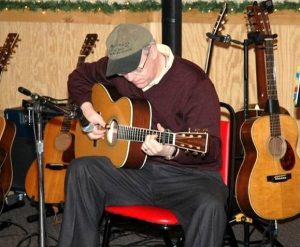[divider top=”1″ bottom=”0″][/divider]
[one_half]
[divider top=”1″ bottom=”0″][/divider]
On Guitar Playing
I’d like to offer a few general comments that relate to my own playing and musical interests, that may be helpful to you or stimulating to your thinking about music.
In the course of rendering music that is meaningful to me, I like to exploit the special attributes of the guitar–those that distinguish it from certain other instruments (in some cases, for example, the piano; in others, the harp). I use vibrato and sustained notes, hammer-ons and pull-offs, string snapping, slides, harmonics, unison notes and string bends. I combine those techniques with arpeggios and cross-string picking, counterpoint, and walking bass lines. (Cross-string picking means basically playing sequential notes on different strings of the guitar, rather than on the same string.)
I play with a combination of flesh and nails, and use a thumb pick to give strength to my bass lines. The thumb pick brings ease to my arpeggiation across the strings, and forces my fingers to play with maximum power, to raise the overall volume of the instrument, and thereby to allow for a greater dynamic range in my playing. I find it appealing to play musical phrases “rubato” (with rhythmic flexibility), probably because of my background in a cappella choral singing. Playing freely lets the music breathe, and altering speed, attack and dynamics, as appropriate, help bring drama and urgency to the tune–which helps to maintain the interest of the listener (and the player!)
Here’s a suggestion for your vibrato. Try working the fretted string back and forth across, rather than parallel to, the fingerboard, using only the fretting finger, without the palm or thumb of the left hand as an anchor in back of the guitar neck. Mastering this difficult technique can enhance one’s playing greatly.
[divider top=”0″ bottom=”0″][/divider]
About El’s Guitar Strings
El uses ELIXIR strings.
ELIXIR is a trademark of W. L. Gore and Associates.
[divider top=”0″ bottom=”1″][/divider]
About El’s Guitar Tuning
Click Here to check out my chord chart in CGDGAD tuning.
[/one_half]
[divider top=”0″ bottom=”1″][/divider]
[one_half_last][/one_half_last]
